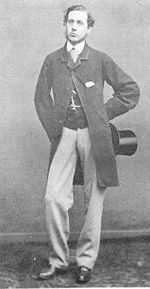- Charles Eamer Kempe
-
 RWB Hornby memorial window at York Minster (by Kempe)
RWB Hornby memorial window at York Minster (by Kempe)
Charles Eamer Kempe (29 June 1837 - 29 April 1907) was a well-known Victorian stained glass designer. After attending Twyford School, he studied for the priesthood at Pembroke College, Oxford, but it became clear that his severe stammer would be an impediment to preaching. He decided that "if I was not permitted to minister in the Sanctuary I would use my talents to adorn it", and went to study architecture with the firm of George Frederick Bodley, where he learned the art of decorating church walls and ceilings. During this part of his life he was making a serious study of mediaeval stained glass, and in 1866 he opened a studio of his own in London, supplying not only stained glass to Bodley's firm but also furnishings and vestments. By 1899 he had over fifty employees.
As a trademark, the firm used a golden garb or wheatsheaf, taken from Kempe's own coat of arms[1]. After his death, the firm was taken over by Kempe's cousin, Walter Tower, and thenceforth used a black tower above the golden garb. A lack of orders caused by the Great Depression ended the firm's life in 1934.
Kempe was a rather shy person, who never married. He had a dog called Nora. His maternal grandfather was Sir John Eamer, who served as Lord Mayor of London in 1801.
Rosalie Glynn Grylls, Lady Mander, whose home Wightwick Manor, near Wolverhampton, contains many pieces of Kempe's stained glass, wrote in 1973:
- Kempe's work has a unique charm; its colours shine out from jewels that cluster on the mitres or the crowns his figures wear and from their peacocks' feathers, while angels playing their instruments are drawn with tender delicacy and scattered above the main windows informally but making a pattern of precision. Above all, the prevailing yellow wash is literally translucent, for it lets through the rays of the full or the setting sun...
Kempe is buried in the churchyard at St Wulfran's Church, Ovingdean.[2] Unfortunately, most of Kempe's records were disposed of after the firm shut in 1934. [3]
See also
 Stained glass window in Bristol Cathedral by C. E. Kempe: King Alfred, Richard Hakluyt, Richard Hooker & William Shakespeare
Stained glass window in Bristol Cathedral by C. E. Kempe: King Alfred, Richard Hakluyt, Richard Hooker & William Shakespeare
- Stained glass
- Stained glass - British glass, 1811-1918
- Victorian Era
- Gothic Revival
- St. Thomas of Canterbury Church, Chester[4]
References
- ^ http://books.google.fi/books?id=LlQOAAAAQAAJ&pg=PA471&lpg=PA471&dq=%22garb+or%22
- ^ Dale, Antony. Brighton Churches. London EC4: Routledge. p. 207. ISBN 0-415-00863-8.
- ^ M. Saunders, “Appreciating Victorian and Arts and Crafts Stained Glass: A Battle Half Won,” Ecclesiology Today. Vol. 40 (JULY 2008), p88.
- ^ A short history of our church building by Ian Thomas (Parish Magazine September 2010)
External links
Categories:- 1837 births
- 1907 deaths
- British stained glass artists and manufacturers
- History of glass
- Alumni of Pembroke College, Oxford
- Old Twyfordians
Wikimedia Foundation. 2010.

